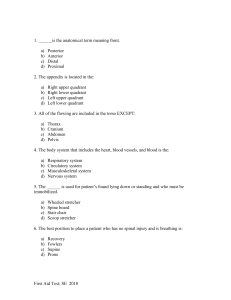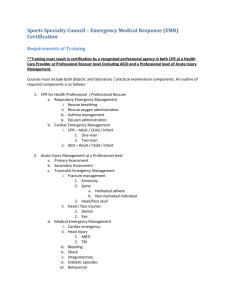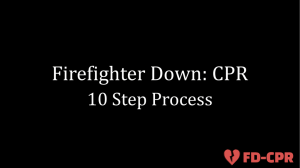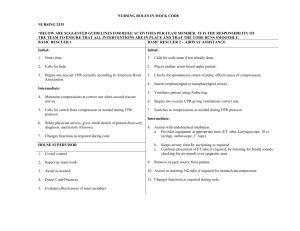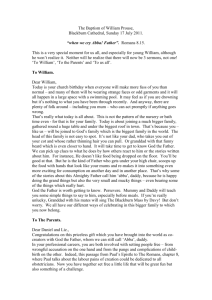Scottish Casualty Care Syllabus - Mountain Rescue Committee of
advertisement
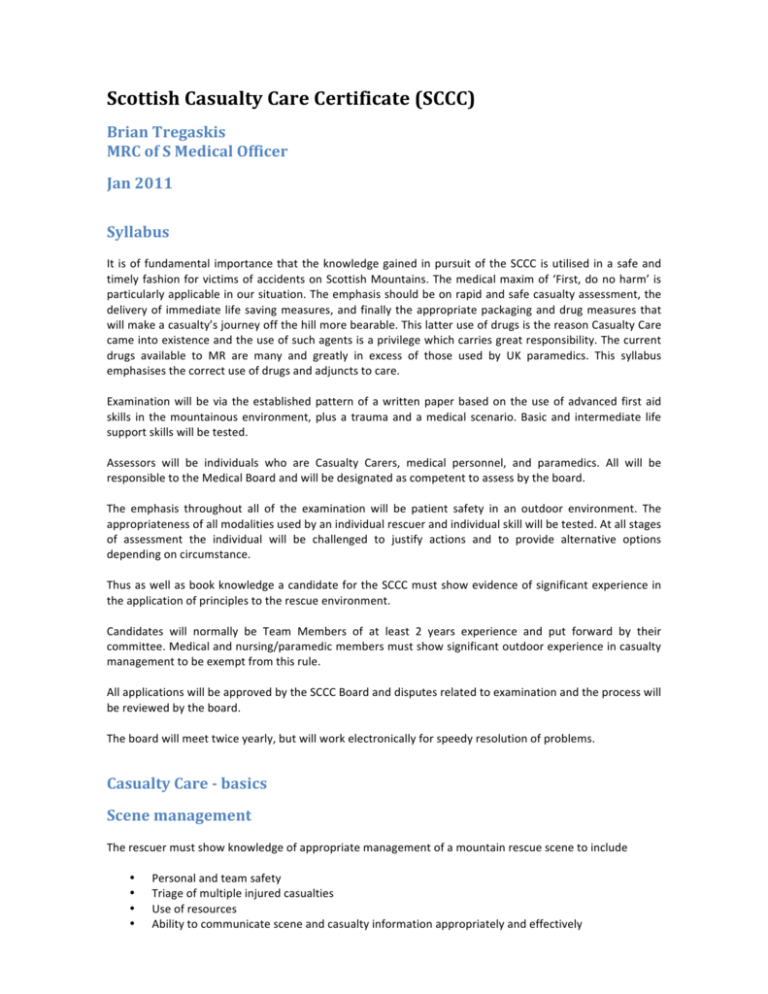
Scottish Casualty Care Certificate (SCCC) Brian Tregaskis MRC of S Medical Officer Jan 2011 Syllabus It is of fundamental importance that the knowledge gained in pursuit of the SCCC is utilised in a safe and timely fashion for victims of accidents on Scottish Mountains. The medical maxim of ‘First, do no harm’ is particularly applicable in our situation. The emphasis should be on rapid and safe casualty assessment, the delivery of immediate life saving measures, and finally the appropriate packaging and drug measures that will make a casualty’s journey off the hill more bearable. This latter use of drugs is the reason Casualty Care came into existence and the use of such agents is a privilege which carries great responsibility. The current drugs available to MR are many and greatly in excess of those used by UK paramedics. This syllabus emphasises the correct use of drugs and adjuncts to care. Examination will be via the established pattern of a written paper based on the use of advanced first aid skills in the mountainous environment, plus a trauma and a medical scenario. Basic and intermediate life support skills will be tested. Assessors will be individuals who are Casualty Carers, medical personnel, and paramedics. All will be responsible to the Medical Board and will be designated as competent to assess by the board. The emphasis throughout all of the examination will be patient safety in an outdoor environment. The appropriateness of all modalities used by an individual rescuer and individual skill will be tested. At all stages of assessment the individual will be challenged to justify actions and to provide alternative options depending on circumstance. Thus as well as book knowledge a candidate for the SCCC must show evidence of significant experience in the application of principles to the rescue environment. Candidates will normally be Team Members of at least 2 years experience and put forward by their committee. Medical and nursing/paramedic members must show significant outdoor experience in casualty management to be exempt from this rule. All applications will be approved by the SCCC Board and disputes related to examination and the process will be reviewed by the board. The board will meet twice yearly, but will work electronically for speedy resolution of problems. Casualty Care -­ basics Scene management The rescuer must show knowledge of appropriate management of a mountain rescue scene to include • Personal and team safety • Triage of multiple injured casualties • Use of resources • Ability to communicate scene and casualty information appropriately and effectively Individual casualty management The rescuer must show facility at immediate casualty management to include: • Intermediate life support skills • Rapid effective primary survey • Appropriate use of analgesics and other advanced techniques for individual patient • Awareness of means of extraction • Safe packaging of casualty for transfer It is desirable that if transfer is delayed a rescuer should be able to perform an appropriate Secondary Survey to identify all possible injuries. This is not necessary in all rescue circumstances Basic and Intermediate Life Support The rescuer must show knowledge of the current Resuscitation guidelines for adults and children. Wherever possible any manoeuvres described should be accompanied by midline stabilisation of the neck Within this framework the rescuer should perform:-­‐ • Head tilt • Chin lift • Jaw thrust • Application of mask • Initiation of Oxygen therapy If the casualty is in cardiac arrest the rescuer should be able to appropriately initiate cardiopulmonary respiration( CPR). He should be able to discuss the pros and cons of commencement of CPR and rules for discontinuation. The rescuer is required to show • A knowledge of current 1 and 2 provider CPR schedules. These can be obtained from the Resuscitation Council website. • Effective airway and chest compression technique • Recognition of complications of CPR In addition to the above a rescuer will be required to be capable of insertion of: • Guedel airway • Nasopharyngeal airway With regard to the above methods of sizing, insertion and awareness of complications will be tested Knowledge of further airway management techniques is desirable. If the rescuer chooses to use any, their use must be justified and a high degree of competence in insertion will be tested. The ability to assist a provider and to elicit such assistance will be tested in such circumstance: • Laryngeal mask airway • Combi-­‐tube airway Finally knowledge of assistance given at the insertion of a definitive airway by a health care professional is optional but desirable. Endotracheal intubation. Safe handling of sedative and muscle relaxant drugs if asked to assist Oxygen therapy Advanced knowledge is expected in the appropriate use of oxygen therapy with flow rates, masks and assistance devices Definitive surgical airway A rescuer should understand the principles of performing a definitive airway Cricothyrotomy and insertion of device The complications of procedure and oxygen therapy in this situation should be discussed Breathing Knowledge of normal human physiology and assessment for breathing abnormalities is essential. • Safe application of masks. Knowledge of types of mask and usage • Assisting breathing via bag valve. • Initiation of oxygen therapy to include cylinder management, tubing connections, timing of supply and attachment to patient and sledge. • Awareness of monitoring of oxygen delivery • Knowledge of pulse oximetry and its application • Ability to describe capnography if using adjuncts Circulation A rescuer should be able to describe the signs of blood loss and shock and assess the casualty by means of: • Pulse • Capillary refill • Assessment of systolic blood pressure Describe immediate treatment of shock with regard to: • Compression and elevation • Oxygen therapy • Splintage If fluid resuscitation is used the rescuer must be able to justify its use and demonstrate a high degree of competence in adjunct insertion. Treatment at scene should not delay transfer to definitive care Disability • • • • A rescuer should be able to describe simple systems for assessing a patient’s conscious level Safe handling of cervical spine and spine Demonstration of ability at sizing and correct fitting of cervical collar Demonstration and coordination of log rolling for assessment and packaging Exposure A rescuer should be able to describe the diagnosis and field management of hypothermia Fractures Recognition and first aid management of all fractures Correct application of splints Multiple casualty management The rescuer should demonstrate and awareness of triage methods and be able to sensibly describe order of evacuation Primary survey and initial treatment The primary survey should be performed systematically and timeously to identify threats to life and disability The mainstay of the SCCC assessment is the identification and early treatment of obvious and less obvious injury. Candidates will be assessed on the effectiveness of primary survey and any treatment decisions that are made as a result of them Expect to be questioned on decisions made and reasons for them with particular reference to your choice of adjuncts or drugs Safe management of airway, breathing, circulation, disability, exposure and fracture will be repeatedly tested throughout the examination Taking a short medical history If a patient or observer is able to give a history this should be elicited by the rescuer. In relation to any incident the salient points of history should be what happened?, when?, why?, where?, how? and, who was involved? Practice will enable appropriate targeted history to be taken. Acronyms such as AMPLE are helpful and aide memoires are encouraged Any notes taken should be succinct and easily readable. Drugs given should be recorded Knowledge of specific disease presentations In all presentations appropriate early assessment and primary survey is expected. Management of a fall from significant height Rescuers will be expected to apply the basics of management and to assess for injury. Initial treatment, immobilisation and appropriate interventions Management of suspected spinal injury On hill management, handling, log roll and packaging Management of facial injury On hill, prevention of bleeding, complication awareness Management of long bone fractures To include discussion of assessment, pain relief, splintage and packaging Fractures of • Fingers/thumb • Wrist • Elbow • Humerus • Shoulder • Clavicle • Femur • Tibial plateau • Tibia • Patella • Fibula • Ankle • Tarsus • Forefoot Management of common dislocations to include basic recognition, assessment, pain relief, splintage and packaging A knowledge of basic techniques of reduction is desirable but will not be tested unless rescuer volunteers. It is desirable for rescuer to be able to assist a medical professional at reduction in terms of drugs and counter traction Dislocations of • Digits • Elbow • Shoulder • Hip • Knee • Patella • Ankle Management of the unconscious patient A rescuer is expected to assess the patient and to come to general conclusions about the cause. Emphasis is on safe handing and exclusion of immediately treatable condition Management of Head Injury To include management of open and closed injury. Emphasis on safe handling and packaging. Justification for any drugs used. Assessment of conscious level and neurological physical signs (pupil size) with recording of serial measurements Management of the exposed patient A rescuer should demonstrate knowledge of the causation and treatment of hypothermia and prevention of further heat loss. Emphasis is on safe handling A rescuer should demonstrate knowledge of the management of a casualty who appears to be dead Cold injury A rescuer should show knowledge of the management and early assessment of trench foot, frostnip and frostbite. This includes appropriate early management, drug therapy and packaging for transfer Heat injury A rescuer should be able to describe the effects of excessive heat on the body and the initial management of heat shock Cardiac conditions A rescuer is expected to recognise possible cardiac conditions presenting as chest pain. Myocardial Infarction and Angina. Immediate management to include pain relief and drug usage Packaging Use of automatic defibrillator Chest conditions A rescuer is expected to recognise conditions presenting as breathlessness, to include asthma, chronic airways disease, pulmonary embolism, infection Appropriate immediate management of above. Principles of drug usage. Abdominal and pelvic pain A rescuer is expected to rapidly assess and describe possible causes of this presentation with pain. Knowledge of immediate actions if pelvic injury is suspected, appropriate pain relief and packaging for all other causes, Anaphylaxis A rescuer should be able to describe the various presentations of anaphylaxis and allergic phenomena and describe accurately immediate treatment, packaging and care en route to hospital. This includes relevant drug therapy Seizures A rescuer is expected to assess and begin treatment for a patient having a seizure or suspected as having a recent seizure. Knowledge of appropriate packaging to include drug therapy Diabetes Rescuers must demonstrate knowledge of the assessment of diabetic patients presenting acutely. Management of low blood sugar to include signs and symptoms, appropriate drug usage. Complications and after care. Management of high blood sugar in the pre hospital environment to include assessment, care during transport and any relevant interactions Eye conditions The rescuer should demonstrate knowledge of assessment of eye injury, chemical and allergic conditions. Relevant pre hospital care and treatment should be described. Headache A rescuer should be able to take a relevant history of headache to decide on severity and likely causes, while initiating appropriate therapy and evacuation. Management of migraine, possible sub arachnoid haemorrhage, cerebral haemorrhage. Emphasis is on early management and appropriate referral Pregnancy and the hill • • • A general understanding of the different presentation and treatment of the pregnant lady Resuscitation Drug usage Management of soft tissue injuries. To include assessment, stabilisation, relevant therapy and interventions. Knowledge of complications including compartment syndrome and its management is desirable. Management of wounds A rescuer should show an ability to recognise and initially treat lacerations, abrasions and scalds. Assessment to include risk assessment, viability, initial treatment and packaging If the rescuer wishes to perform advanced procedures knowledge of relevant anatomy, risks drug usage and materials usage should be demonstrated Management of Bites and stings Basic, topical and drug therapy • Bee, Wasp, Cleg, Horsefly stings • Dog and wild animal bite • Adder Bite. Safe transfer and packaging Lightning injury A rescuer must show basic knowledge of the effects of lightning. A rescuer must describe initial and ongoing care and demonstrate knowledge of the management of the patient who appears to be dead Avalanche A rescuer must show knowledge of the specific patterns of injury associated with avalanche. Emphasis is on early assessment and management with packaging. A rescuer must show knowledge of relevant protocols in common use for the management of the avalanche casualty, particularly the casualty who appears to be dead Near Drowning A rescuer should demonstrate knowledge of the management of the drowned patient with emphasis on early assessment and intervention. Knowledge of protocols to help with the management of the patient who appears to be dead is desirable. Diving medicine A rescuer should show knowledge of the diagnosis and immediate management of diving related incidents to include barotraumas, the bends and incipient bends. Emphasis is on pattern recognition, appropriate initial management and transfer. Suspension trauma A rescuer should be familiar with the presentation of symptoms as a result of suspension. He should describe immediate management with regard to position and packaging and prevention of further decline. Crush syndrome A rescuer should show some knowledge of problems related to crush injury including appropriate early management Ballistic injury A rescuer should be capable of assessing a victim of gunshot or blast injury, identify problems and start basic treatment. Drug therapy in mountain rescue The appropriate use of drugs is emphasised throughout the examination. Rescuers are expected to know the following with reference to any drug they choose to use Drug name and brand name. Use by date Drug recognition, packaging, dosage on packet, identification in internal packaging. Indication for drug use in the pre hospital environment Drug dose and method of administration, to include range of dosage and frequency Drug contraindications and assessment of individual patient suitability. Immediate response to drug complication Likely effects of drug and monitoring until patient at definitive care It is assumed that drugs are stored correctly and within date. A rescuer giving a drug will have to show knowledge of individual storage conditions for drug used by his team For each drug used rescuer must know the indications and discuss any alternative measures possible and desirable. The following is the Scottish MR drug formulary for individual use. Abbreviation sc=subcutaneous, im= intramuscular, oral, sl = sublingual, inh=inhaled • Adrenaline 1/1000 1mg sc/im/ • Aspirin 300mg oral • Epipen 0.3mg im • Codeine Phosphate 30mg oral • Diclofenac 50mg oral • Glyceryl trinitrate spray sl • Glucogel oral or buccal spread • Morphine/cyclimorph 10mg im,sc, iv • Naloxone 400microgrammes sc • Povidone iodine topical • Prochlorperazine (buccastem) sl • Salbutamol inh Knowledge of specialist drugs is not required for the casualty care certificate. Any rescuer wishing to give other drugs in particular circumstances will need to justify as above and be questioned accordingly Advanced techniques These are not assessed but it is desirable that a rescuer taking SCCC is aware of interventions and can help under guidance a fellow rescuer with appropriate training. Needle Thoracocentesis, principles and practice Chest drain insertion Procedure under altered consciousness with reference to airway control, in procedure care and aftercare. • Reduction of dislocation and fracture • Ketamine anaesthesia • Endotracheal intubation • Laryngeal mask intubation • Cricothyrotomy • Control of seizure with diazepam, midazolam Summary In summary, the examination for casualty care certificate is an assessment of the core basic knowledge in the areas above and its application in the mountain rescue environment. The aim is to drive up the standard of care not to frighten. Knowledge can be gained by appropriate courses and of course by rescuing. Learning should be facilitated by appropriate team training. The SCCC group and examiners will from tine to time modify the syllabus, which is designed as a basic guide to the knowledge assumed for sitting the examination. The standard of passing the certificate will be a high standard of proficiency at basic management of casualties in the pre hospital mountain environment. Advanced techniques are not assessed but if offered by a candidate will be subjected to examination.
